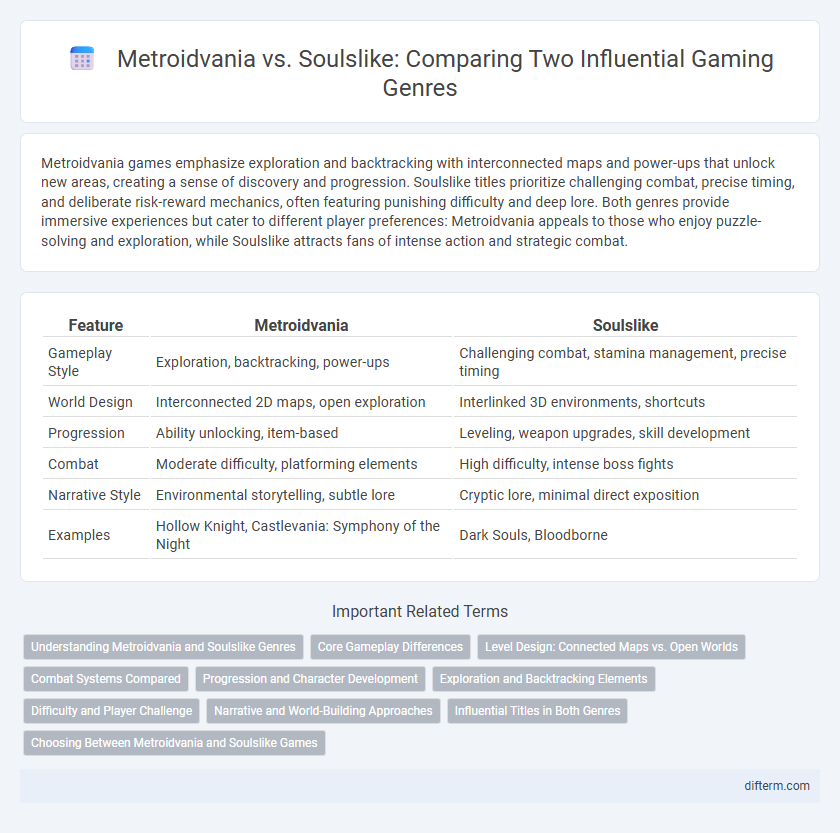Metroidvania games emphasize exploration and backtracking with interconnected maps and power-ups that unlock new areas, creating a sense of discovery and progression. Soulslike titles prioritize challenging combat, precise timing, and deliberate risk-reward mechanics, often featuring punishing difficulty and deep lore. Both genres provide immersive experiences but cater to different player preferences: Metroidvania appeals to those who enjoy puzzle-solving and exploration, while Soulslike attracts fans of intense action and strategic combat.
Table of Comparison
| Feature | Metroidvania | Soulslike |
|---|---|---|
| Gameplay Style | Exploration, backtracking, power-ups | Challenging combat, stamina management, precise timing |
| World Design | Interconnected 2D maps, open exploration | Interlinked 3D environments, shortcuts |
| Progression | Ability unlocking, item-based | Leveling, weapon upgrades, skill development |
| Combat | Moderate difficulty, platforming elements | High difficulty, intense boss fights |
| Narrative Style | Environmental storytelling, subtle lore | Cryptic lore, minimal direct exposition |
| Examples | Hollow Knight, Castlevania: Symphony of the Night | Dark Souls, Bloodborne |
Understanding Metroidvania and Soulslike Genres
Metroidvania games emphasize exploration, interconnected maps, and character progression through acquiring new abilities, blending action and puzzle-solving elements. Soulslike titles prioritize punishing difficulty, precise combat mechanics, and immersive storytelling often conveyed through environmental cues and minimal exposition. Both genres demand player skill and strategic thinking but diverge in pacing and narrative delivery, catering to distinct gaming experiences.
Core Gameplay Differences
Metroidvania games emphasize exploration, non-linear level design, and ability-based progression that unlocks new areas and secrets. Soulslike titles focus on challenging combat, stamina management, and precise timing, often featuring interconnected worlds with high difficulty and risk-reward mechanics. While Metroidvanias prioritize discovery and platforming, Soulslikes demand strategic combat mastery and resilience.
Level Design: Connected Maps vs. Open Worlds
Metroidvania games feature intricately connected maps designed to encourage exploration through shortcuts, secret rooms, and gated progression requiring specific abilities. Soulslike titles favor open worlds or semi-open hubs that promote nonlinear exploration, emphasizing atmospheric tension and strategic encounters within expansive environments. The difference in level design greatly influences gameplay flow, with Metroidvanias offering tight, puzzle-like navigation versus Soulslikes providing broader, dynamic combat arenas.
Combat Systems Compared
Metroidvania games feature combat systems emphasizing exploration and methodical enemy encounters with a focus on agility, environmental navigation, and ability-based progression. Soulslike combat is defined by deliberate, stamina-based mechanics requiring precise timing, strategic positioning, and punishing enemy patterns to overcome challenging bosses. Both genres prioritize skillful combat but differ in pacing, with Metroidvania favoring fluidity and exploration while Soulslike prioritizes tension and precision.
Progression and Character Development
Metroidvania games emphasize exploration-based progression where unlocking new abilities and areas drives character growth and gameplay advancement. Soulslike titles focus on skill mastery and incremental strength improvements through combat challenges, with character development tied to player adaptability and strategic resource management. Both genres prioritize player investment in character progression but differ in pacing and the integration of narrative elements.
Exploration and Backtracking Elements
Metroidvania games emphasize intricate level design with interconnected maps that reward thorough exploration and require strategic backtracking to unlock new areas using acquired abilities. Soulslike titles integrate exploration with a risk-reward approach, where players must navigate challenging environments and carefully manage resources while revisiting locations to uncover shortcuts or hidden secrets. The exploration in Metroidvania centers on map progression and ability gating, whereas Soulslike exploration is coupled with dynamic enemy encounters and environmental storytelling.
Difficulty and Player Challenge
Metroidvania games emphasize exploration and progression with moderate difficulty, requiring players to solve intricate puzzles and backtrack through interconnected world maps. Soulslike titles are characterized by punishing difficulty, demanding precise combat skills, strategic resource management, and high player adaptability to overcome formidable enemies and bosses. Both genres challenge players uniquely: Metroidvania focuses on skillful navigation and upgrades, while Soulslike tests endurance, timing, and tactical combat decisions.
Narrative and World-Building Approaches
Metroidvania games emphasize interconnected world design with narrative revealed through environmental storytelling and exploration, creating a cohesive universe that rewards player curiosity. Soulslike titles adopt fragmented storytelling, where lore is often embedded in item descriptions, NPC dialogue, and minimalist cutscenes, fostering a mysterious and interpretive experience. Both genres prioritize immersive world-building but diverge in narrative delivery, with Metroidvania leaning towards organic discovery and Soulslike encouraging player-driven interpretation.
Influential Titles in Both Genres
Metroidvania titles such as "Castlevania: Symphony of the Night" and "Hollow Knight" popularized non-linear exploration and ability-based progression, setting genre standards. Soulslike games like "Demon's Souls" and "Dark Souls" emphasize challenging combat, intricate level design, and deep lore, influencing numerous developers. Both genres contribute significantly to modern action-adventure gaming, inspiring innovative mechanics and atmospheric narratives.
Choosing Between Metroidvania and Soulslike Games
Choosing between Metroidvania and Soulslike games depends on player preference for exploration versus challenge. Metroidvania titles emphasize interconnected maps, ability progression, and backtracking, ideal for players who enjoy discovery and story-driven gameplay. Soulslike games focus on difficult combat, intricate enemy design, and strategic resource management, appealing to those who seek intense, skill-based experiences.
Metroidvania vs Soulslike Infographic

 difterm.com
difterm.com